3.4 Hydrogen Supply Chains
After you have learned about the different technologies for storing and transporting hydrogen in the previous two sections, you will learn in this last part of the chapter what future supply chains for green hydrogen could look like. The term hydrogen supply chain describes the entirety of all process steps and the technologies applied between the production of the initial raw materials (e.g. renewable electricity) and the end use of the hydrogen or the derivative.
1. Supply chains
The general components of green hydrogen supply chains are shown in the figure below. The production of hydrogen via electrolysis is the central element of all supply chains. Renewable electricity and treated water are needed for the electrolytic production of green hydrogen. Usually, the hydrogen cannot be consumed directly at the place of its production. Therefore, the next step in the supply chain is conditioning for storage or transport (see 3.2 Hydrogen Storage). The type of this conditioning depends on the form in which the hydrogen is to be transported and stored. If ammonia, methanol or a synthetic fuel is produced, additional feedstock substance (carbon dioxide or nitrogen) is needed in addition to electrical energy and water. If LOHCs are used for the storage and transport of hydrogen, a respective carrier liquid is needed.

To illustrate this, three supply chains for providing different consumers with green hydrogen or its derivatives are presented in the following. Since, as already mentioned, there are currently no supraregional supply chains for green hydrogen, the examples presented here only illustrate possible future scenarios that are realistic from today's perspective.